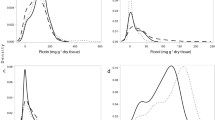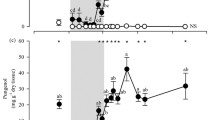Abstract
Plants encounter a broad range of natural enemies and defend themselves in diverse ways. The cost of defense can be reduced if a plant secondary metabolite confers resistance to multiple herbivores. However, there are few examples of positively correlated defenses in plants against herbivores of different types. We present evidence that a genetically variable chemical trait that acts as a strong antifeedant to mammalian herbivores of Eucalyptus also deters insect herbivores, suggesting a possible mechanism for cross-resistance. We provide field confirmation that sideroxylonal, an important antifeedant for mammalian herbivores, also determines patterns of damage by Christmas beetles, a specialist insect herbivore of Eucalyptus. In a genetic progeny trial of Eucalyptus tricarpa, we found significant heritabilities of sideroxylonal concentration (0.60), overall insect damage (0.34), and growth traits (0.30–0.53). Population of origin also had a strong effect on each trait. Negative phenotypic correlations were observed between sideroxylonal and damage, and between damage and growth. No relationship was observed between sideroxylonal concentration and any growth trait. Our results suggest that potential for evolution by natural selection of sideroxylonal concentrations is not strongly constrained by growth costs and that both growth and defense traits can be successfully incorporated into breeding programs for plantation trees.

Similar content being viewed by others
References
American Society for Testing and Materials (1995) Standard practices for infrared, multivariate, quantitative analysis. Designation: E1655–94. West Conshohocken, PA
Andrew RL, Peakall R, Wallis IR, Wood JT, Knight EJ, Foley WJ (2005) Can marker-based quantitative genetics in the wild be successful? Heritability and genetic correlation of chemical defences in Eucalyptus. Genetics 171:1989–1998
Andrew RL, Peakall R, Wallis IR, Foley W (2007) Spatial distribution of defense chemicals and markers: implications for the maintenance of variation. Ecology 87:716–728
Bowers MD, Collinge SK, Gamble SE, Schmitt J (1992) Effects of genotype, habitat, and seasonal variation on iridoid glycoside content of Plantago lanceolata (Plantaginaceae) and the implications for insect herbivores. Oecologia 91:201–207
Brooker MIH, Kleinig DA (1999) Field guide to eucalypts volume 1: South-Eastern Australia, 2nd edn. Bloomings Books, Hawthorn
Burgess IP, Williams ER, Bell JC, Harwood CE, Owen JV (1996) The effect of outcrossing rate on the growth of selected families of Eucalyptus grandis. Silvae Genet 45:97–100
Butcher PA, Williams ER (2002) Variation in outcrossing rates and growth in Eucalyptus camaldulensis from the Petford Region, Queensland; evidence of outbreeding depression. Silvae Genet 51:6–12
Carne PB, Greaves RTG, McInnes RS (1974) Insect damage to plantation-grown eucalypts in north coastal New South Wales, with particular reference to Christmas beetles (Coleoptera: Scarabaeidae). J Aust Entomol Soc 13:189–206
Costa e Silva J, Potts BM, Dutkowski GW (2006) Genotype by environment interaction for growth of Eucalyptus globulus in Australia. Tree Genet Genomes 2:61–75
Edwards PB, Wanjura WJ, Brown WV (1993) Selective herbivory by Christmas beetles in response to intraspecific variation in Eucalyptus terpenoids. Oecologia 95:551–557
Eldridge K, Davidson J, Harwood C, Van Wyk G (1993) Eucalypt domestication and breeding. Clarendon Press, Oxford, UK
Floyd RB, Foley WJ (2001) Identifying pest-resistant eucalypts using near-infrared spectroscopy. RIRDC Publication No 01/112. Rural Industries Research and Development Corporation, Canberra, Australia
Fornoni J, Nunez-Farfan J, Valverde PL, Rausher MD (2004) Evolution of mixed strategies of plant defense allocation against natural enemies. Evolution 58:1685–1695
Gill AM (1997) Eucalypts and fires: interdependent or independent? In: Williams J, Woinarski J (eds) Eucalypt ecology: individuals to ecosystems. Cambridge University Press, Cambridge, pp 151–167
Griffin AR, Cotterill PP (1988) Genetic variation in growth of outcrossed, selfed and open-pollinated neighbourhood inbreeding progenies of Eucalyptus regnans and some implications for breeding strategy. Silvae Genet 37:124–131
Harwood CE, Bulman P, Bush D, Mazanec R, Stackpole D (2001) Australian low rainfall tree improvement group: compendium of hardwood breeding strategies. Rural Industries Research and Development Corporation, Canberra
Haukioja E (2003) Putting the insect into the birch-insect interaction. Oecologia 136:161–168
Henery M (2006) Foliar secondary metabolites in Eucalyptus and their role in resistance to defoliating insects. PhD Thesis, The Australian National University, Canberra, Australia
Hijmans RJ, Cameron SE, Parra JL, Jones PG, Jarvis A (2005) Very high resolution interpolated climate surfaces for global land areas. Int J Climatol 25:1965–1978
Hill KD, Johnson LAS (1991) Systematic studies in eucalypts 3. New taxa and combinations in Eucalyptus (Myrtaceae). Telopea 4:223–267
Johns CV, Stone C, Hughes L (2004) Feeding preferences of the Christmas beetle Anoplognathus chloropyrus (Coleoptera: Scarabaeidae) and four paropsine species (Coleoptera: Chrysomelidae) on selected Eucalyptus grandis clonal foliage. Aust For 67:184–190
Jones TH, Potts BM, Vaillancourt RE, Davies NW (2002) Genetic resistance of Eucalyptus globulus to autumn gum moth defoliation and the role of cuticular waxes. Can J For Res 32:1961–1969
Jones RC, McKinnon GE, Potts BM, Vaillancourt RE (2005) Genetic diversity and mating system of an endangered tree Eucalyptus morrisbyi. Aust J Bot 53:11
Jordan GJ, Potts BM, Clarke AR (2002) Susceptibility of Eucalyptus globulus ssp globulus to sawfly (Perga affinis ssp insularis) attack and its potential impact on plantation productivity. For Ecol Man 160:189–199
Koricheva J (2002) Meta-analysis of sources of variation in fitness costs of plant antiherbivore defenses. Ecology 83:176–190
Kotanen PM, Rosenthal JP (2000) Tolerating herbivory: does the plant care if the herbivore has a backbone? Evol Ecol 14:537–549
Kursar TA, Coley PD (2003) Convergence in defense syndromes of young leaves in tropical rainforests. Biochem Syst Ecol 31:929–949
Lawler IR, Foley WJ, Pass GJ, Eschler BM (1998) Administration of a 5HT3 receptor antagonist increases the intake of diets containing Eucalyptus secondary metabolites by marsupials. J Comp Physiol B 168:611–618
Lawler IR, Stapley J, Foley WJ, Eschler BM (1999) Ecological example of conditioned flavor aversion in plant–herbivore interactions: effect of terpenes of Eucalyptus leaves on feeding by common ringtail and brushtail possums. J Chem Ecol 25:401–415
Lawler IR, Foley WJ, Eschler BM (2000) Foliar concentration of a single toxin creates habitat patchiness for a marsupial folivore. Ecology 81:1327–1338
Leimu R, Koricheva J (2006) A meta-analysis of genetic correlations between plant resistances to multiple enemies. Am Nat 168:E15–E37
Lopez GA, Potts BM, Vaillancourt RE, Apiolaza LA (2003) Maternal and carryover effects on early growth of Eucalyptus globulus. Can J For Res 33:2108
Lynch M, Walsh B (1998) Genetics and analysis of quantitative traits. Sinauer, Sunderland, Mass
McDonald MW, Rawlings M, Butcher PA, Bell JC (2003) Regional divergence and inbreeding in Eucalyptus cladocalyx (Myrtaceae). Aust J Bot 51:393–403
McKay JK, Latta RG (2002) Adaptive population divergence: markers, QTL and traits. Trends Ecol Evol 17:285–291
Merila J, Crnokrak P (2001) Comparison of genetic differentiation at marker loci and quantitative traits. J Evol Biol 14:892–903
Moore BD, Foley WJ (2005) Tree use by koalas in a chemically complex landscape. Nature 435:488–490
Moore BD, Wallis IR, Pala-Paul J, Brophy JJ, Willis RH, Foley WJ (2004a) Antiherbivore chemistry of Eucalyptus—cues and deterrents for marsupial folivores. J Chem Ecol 30:1743–1769
Moore BD, Wallis IR, Wood JT, Foley WJ (2004b) Foliar nutrition, site quality, and temperature influence foliar chemistry of tallowwood (Eucalyptus microcorys). Ecol Monogr 74:553–568
Moore BD, Foley WJ, Wallis IR, Cowling A, Handasyde KA (2005) Eucalyptus foliar chemistry explains selective feeding by koalas. Biol Lett 1:64–67
Mutikainen P, Walls M, Ovaska J, Keinänen M, Julkunen-Tiitto R, Vapaavuori E (2002) Costs of herbivore resistance in clonal saplings of Betula pendula. Oecologia 133:364–371
O’Reilly-Wapstra JM, McArthur C, Potts BM (2002) Genetic variation in resistance of Eucalyptus globulus to marsupial browsers. Oecologia 130:289–296
O’Reilly-Wapstra JM, McArthur C, Potts BM (2004) Linking plant genotype, plant defensive chemistry and mammal browsing in a Eucalyptus species. Funct Ecol 18:677–684
Payne RW (ed) (2005) The guide to genstat release 8 Part 2: statistics. VSN International, Oxford, UK
Pryor LD (1953) Variable resistance to leaf-eating insect in some eucalypts. Proc Linn Soc NSW 77:364–368
Puustinen S, Koskela T, Mutikainen P (2004) Direct and ecological costs of resistance and tolerance in the stinging nettle. Oecologia 139:76
Rapley LP, Allen GR, Potts BM (2004) Genetic variation in Eucalyptus globulus in relation to susceptibility from attack by the southern eucalypt leaf beetle, Chrysophtharta agricola. Aust J Bot 52:10
Rausher MD (1996) Genetic analysis of coevolution between plants and their natural enemies. Trends Genet 12:212–217
Raymond CA (1995) Genetic variation in Eucalyptus regnans and Eucalyptus nitens for levels of observed defoliation caused by the eucalyptus leaf-beetle, Chrysophtharta bimaculata Olivier, in Tasmania. For Ecol Man 72:21–29
Rice WR (1989) Analyzing tables of statistical tests. Evolution 43:223–225
Rosner S, Hannrup B (2004) Resin canal traits relevant for constitutive resistance of Norway spruce against bark beetles: environmental and genetic variability. For Ecol Man 200:77–87
Rousi M, Tahvanainen J, Henttonen H, Herms DA, Uotila I (1997) Clonal variation in susceptibility of white birches (Betula spp.) to mammalian and insect herbivores. For Sci 42:396–402
Scrivener NJ, Johnson CN, Wallis IR, Takasaki M, Foley WJ, Krockenberger AK (2004) Which trees do wild common brushtail possums (Trichosurus vulpecula) prefer? Problems and solutions in scaling laboratory findings to diet selection in the field. Evol Ecol Res 6:77–87
Shepherd M (2000) Variation and inheritance of resistance to defoliation by Christmas beetles, Anoplognathus sp. (Leach) in eucalypts. For Genet 7:57–64
Siemens DH, Lischke H, Maggiulli N, Schurch S, Roy BA (2003) Cost of resistance and tolerance under competition: the defense-stress benefit hypothesis. Evol Ecol 17:247–263
Squillace AE (1974) Average genetic correlations among offspring from open-pollinated forest trees. Silvae Genet 23:149–156
Tibbits W, Hodge G (1998) Genetic parameters and breeding value predictions for Eucalyptus nitens wood fiber production traits. For Sci 44:587–598
Wallis IR, Watson ML, Foley WJ (2002) Secondary metabolites in Eucalyptus melliodora: field distribution and laboratory feeding choices by a generalist herbivore, the common brushtail possum. Aust J Zool 50:507–519
Wallis IR, Herlt AJ, Eschler BM, Takasaki M, Foley WJ (2003) Quantification of sideroxylonals in Eucalyptus foliage by high-performance liquid chromatography. Phytochem Anal 14:360–365
Warren CR, Tausz M, Adams MA (2005) Does rainfall explain variation in leaf morphology and physiology among populations of red ironbark (Eucalyptus sideroxylon subsp tricarpa) grown in a common garden? Tree Physiol 25:1369–1378
Williams ER, Matheson AC, Harwood CE (2002) Experimental design and analysis for tree improvement, 2nd edn. CSIRO Publishing, Collingwood
Acknowledgments
The authors thank Emlyn Williams for statistical advice, and Nadine Scholtz and Junko Kondo for assistance in field and laboratory work. We are grateful to Jim and Jane Rowe and later Sharon and Lockie Altmeier for access to their property and to ALRTIG for providing background information on the trial. We also thank Ian Johnson and Hans Porada of Forests NSW for their support and assistance. We thank Brian Baltunis and anonymous reviewers for their comments on the manuscript. The work was funded by grants from the Australian Research Council and the Rural Industries Research and Development Corporation (RIRDC) to W.J.F. and by a scholarship from RIRDC and the Australian National University to R.L.A. This study complies with the laws of the country in which it was conducted, Australia.
Author information
Authors and Affiliations
Corresponding author
Additional information
Communicated by Julia Koricheva.
Rights and permissions
About this article
Cite this article
Andrew, R.L., Wallis, I.R., Harwood, C.E. et al. Heritable variation in the foliar secondary metabolite sideroxylonal in Eucalyptus confers cross-resistance to herbivores. Oecologia 153, 891–901 (2007). https://doi.org/10.1007/s00442-007-0784-1
Received:
Accepted:
Published:
Issue Date:
DOI: https://doi.org/10.1007/s00442-007-0784-1




